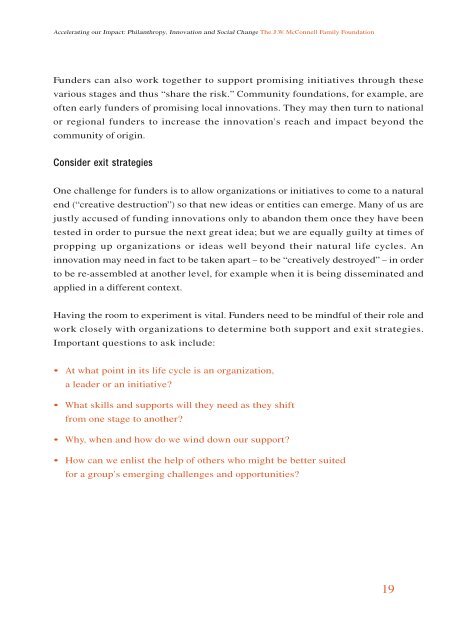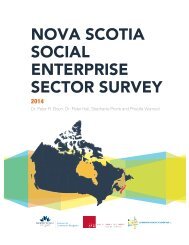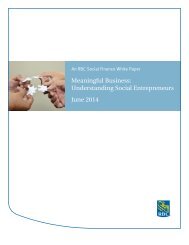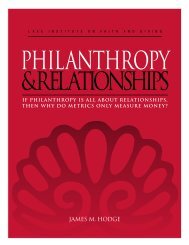Accelerating our Impact: Philanthropy, Innovation and Social Change
You also want an ePaper? Increase the reach of your titles
YUMPU automatically turns print PDFs into web optimized ePapers that Google loves.
<strong>Accelerating</strong> <strong>our</strong> <strong>Impact</strong>: <strong>Philanthropy</strong>, <strong>Innovation</strong> <strong>and</strong> <strong>Social</strong> <strong>Change</strong> The J.W. McConnell Family Foundation<br />
Complexity theory offers another framework for underst<strong>and</strong>ing the processes involved<br />
in social innovation <strong>and</strong> transformation. As with panarchy, it too is modeled on biology.<br />
However “complexity science is not a single theory. It is the study of complex adaptive<br />
systems – the patterns of relationships within them, how they are sustained, how they<br />
self-organize <strong>and</strong> how outcomes emerge…The science encompasses more than one theoretical<br />
framework… [it] is highly interdisciplinary including biologists, anthropologists,<br />
economists, sociologists, management theorists <strong>and</strong> many others in a quest to<br />
answer some fundamental questions about living, adaptable, changeable systems.” 10<br />
1.2<br />
Complexity theory<br />
Reduced to its essentials, complexity science reminds us that social change is complex,<br />
not simple; emergent, not fixed; <strong>and</strong> generally, although not always, long term<br />
rather than quick.<br />
Again, there are implications for funders, the major one being accepting the<br />
unpredictable nature of social change processes. Paradoxes <strong>and</strong> contradictions will<br />
inevitably emerge in any change initiative, <strong>and</strong> can prove to be fertile ground for<br />
innovation, especially if they can be balanced rather than resolved through the forced<br />
selection of one alternative over another. In many cases, the answer should not be<br />
“either/or”, but rather “both/<strong>and</strong>”. For example, one can be purposeful while allowing<br />
for ideas <strong>and</strong> directions to emerge; hold to a higher vision while attending to the practical<br />
dimensions of change initiatives; <strong>and</strong> so forth. Being innovative means allowing<br />
for surprises <strong>and</strong> unintended consequences, being comfortable with the unknown,<br />
<strong>and</strong> learning from mistakes. Margaret Wheatley 11 has observed “The things we fear<br />
most in organizations – fluctuations, disturbances, imbalances – are the primary<br />
s<strong>our</strong>ces of creativity.”<br />
One is not working entirely in the dark, however. Complexity theory 12 provides some<br />
insights into what to expect <strong>and</strong> how to work on change in complex environments.<br />
Underst<strong>and</strong>ing complexity can serve to reassure boards <strong>and</strong> participants that the lack<br />
of a precise blueprint is not an omission or a fault; rather, that the dynamics they are<br />
seeing <strong>and</strong> experiencing are normal. Brenda Zimmerman suggests that organizations<br />
build a good-enough vision by providing minimum specifications rather than trying<br />
to plan every little detail. Have a good enough sense of where you want to go but don't<br />
over-specify <strong>and</strong> don't expect a detailed blueprint.”<br />
10 A Complexity Science Primer: What is Complexity Science <strong>and</strong> Why Should I Learn About It? Page 3<br />
< http://www.plexusinstitute.org > ; adapted from Brenda Zimmerman, Curt Lindberg <strong>and</strong> Paul Plsek:<br />
Edgeware: Lessons From Complexity Science for Health Care Leaders, VHA Inc.: Dallas, 1998.<br />
(Available by calling toll-free 1-866-822-5571 or through Amazon.com).<br />
21







